![]()
![]()
![]()
Use LEFT and RIGHT arrow keys to navigate between flashcards;
Use UP and DOWN arrow keys to flip the card;
H to show hint;
A reads text to speech;
60 Cards in this Set
- Front
- Back
|
As you age...
|
--Will these characteristics stay the same?
In what ways do you think they it will change? --Most older adults have difficulty adapting to change; they are set in their ways. --TRUE or FALSE? |
|
|
Personality: definition
|
--one of the broadest terms in psych
--An enduring pattern of thoughts, feelings, motivations, & behaviors expressed across different situations. --3 parts: 1) traits: distinguishing feature of persons character that remains relatively stable 2) personal concerns: what ppl want and the tech. strategies and plans to get there 3) identity: continuing and coherent sense of self over time |
|
|
Creating identity
|
--Identity assimilation: attempt to fit events in a preconceived view of who we are and downplay events that don't fit
--identity accommodation: events happen that don't fit and we alter our identity --Identity can be found through a LIFE STORY which is made up of: 1) coherence: of events as a whole 2) assimilation: personal interpretation of events 3) structure: beginning middle and end 4) truth |
|
|
Personality: 2 measure
|
--2 Major Methods:
1. Objective Measures of Personality: Asks person to list, sort, or rate themselves on a variety of attributes 2. Projective Measures of Personality: Given an ambiguous stimulus (picture or passage) and person projects their personality onto it. |
|
|
Objective Tests
|
1. Objective Measures of Personality: Asks person to list, sort, or rate themselves on a variety of attributes
--Q-sorts: given a stack of cards w/ personality descriptions and asked to separate them into piles --higher validity and reliability than projective tests |
|
|
Projective Tests
|
--A method for covertly measuring a person's personality
by having them interpret ambiguous stimuli --Thematic apperception test --draw-a-person test --rorscharsch' s inkblot --Projective tests have been described as a “clinician’s delight and a statistician’s nightmare" --less reliable and valid than objective test |
|
|
Trait Theories
|
--Trait theories focus on lay descriptions of people, obtained via self-reports, and grouped via factor analysis
--Allport & Odbert (1936) - 18,000 words related to personality. • Cattell (1957) - uses factor analysis to reduce list to 16 traits. -, Warmth, Intelligence, Emotional Stability, Assertiveness, Seriousness, Conscientiousness, Shyness, Sensitivity, Suspiciousness, Imaginativeness, Privateness, Apprehension, Openness to Change, Self-Reliance, Perfectionism, Tension. • Eysenck (1953) - distinguishes between 3 major traits: 1. Extroversion refers to the degree to which a person is sociable, active, and willing to take risks. 2. Neuroticism refers to a person’s emotional stability and their level of negative affect. 3. Psychoticism refers to the degree to which a person is egocentric, impulsive, and aggressive. |
|
|
The Five Factor Model (FFM)
|
--The Big Five; The OCEAN model
1) Openness to experience: Imaginative, curious, creative, adventurous. 2) Conscientiousness: Organized, clean, disciplined, ambitious. 3) Extroversion: Social, talkative, assertive, active, positive. 4) Agreeableness:Trusting, kind, helpful, cooperative, compliant. 5) Neuroticism: Anxious, insecure, extreme, emotional, unrealistic. |
|
|
The Five Factor Model (FFM): high/low
|
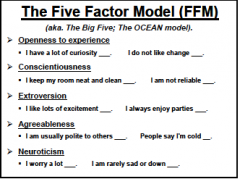
|
|
|
Victoria Study: Which traits show stability or change with age? Small, Hertzog, Hultsch, & Dixon (2003)
|
Aim: to examine if personality changes or
remains the same as people age • Participants: Victoria Study 223 d lt 55 t 85 ld (M 69) – 223 adults: 55 to 85 years old (M age= 69) – 60% female & ethnically diverse – M education = 13 years • Measure: self-reported personality: given twice, 6 years apart |
|
|
Victoria Study: Results 1
|
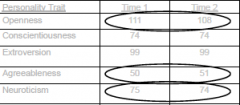
Results 1: examine if mean-level on trait changes
•Mean-levels of personality traits suggest stability in late life -Quantitative changes are small, and mostly positive |
|
|
Victoria Study: Results 2
|
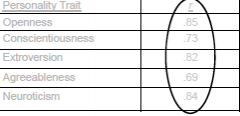
Results 2: stability of rank-order within a group
– examine correlation between times of testing •High positive rank-order correlations suggest stability of personality in late life |
|
|
The Five Factor Model (FFM): Age Differences
|
-Openness to new experience: stable (small decline)
-Conscientiousness: stable -Extraversion: stable -Agreeableness: stable (small increase) -neuroticism: stable (small decline) -Personality is "set in plaster" after the age of 30! |
|
|
Critiques of FFM
|
• Exclusive use of self-report measures
– bias to report stability, or if change, getting better with age • Over-reliance on group data – examine possible intraindividual change: some people stable, others show change • Little consideration of sociocultural context – socialization & life experiences can influence personality … |
|
|
Is Personality Innate? (twins)
|
--The most recent research on the innate basis of personality focuses on Heritability: the degree to which variance in a personality trait is due to genetic influences
--Heritability Estimate = [correlation between identical twins] minus [correlation between fraternal twins] x 2 • Most personality traits (including all of the Big Five) show relatively high heritability estimates (~.15 - .50). |
|
|
Is Personality Innate? Two Factor Model
|

1) High Autonomic (emotional) Activity-Neuroticism
Low Autonomic (emotional) Activity- Stable 2) High Cortical (mental) Arousal- introvert Low Cortical (mental) Arousal- extrotvert |
|
|
Do Traits Really Exist?
|
-- In 1968, Mischel published a major critique of personality research.
--He noted that the ability of personality traits to predict specific behaviors is relatively poor. --And that correlations between self-reported traits and peer ratings were often quite low. --These facts led him to argue that "our behavior is driven more by the SITUATION than by any internal characteristic of the PERSON". --Situational Variables - the circumstances in which we find ourselves --Person-by-Situation Interactions - the expression of particular traits only in certain situations. |
|
|
Personality: Cognitive Factors
|
--The development of personality is affected by people’s
thoughts, goals, and expectations. • Expectancies – what you expect to happen (i.e., locus of control). • Self-Efficacy – beliefs about your capabilities; the sense of being able to produce desired outcomes. --Personal Concerns Perspective: personality is not reducible to traits, but reflects PERSONAL GOALS, that are likely different at EACH STAGE of life |
|
|
Social Influences on Personality: Birth Order
|
•First-Born or Only Child (undivided parent attention): More responsible, ambitious, self-disciplined, & assertive, but also more temperamental & anxious about status.
•Middle-Born: Less identified with family, less likely to ask for help, more likely to live far from home & less likely to visit parents • Last- or Later-Born: More easy-going, trusting, & altruistic; more adventurous & untraditional; more social; but also more self-conscious. |
|
|
Social Influences on Personality: Gender and Peers
|
•Gender
--Women: More social, empathetic, & nurturing; more neurotic. (societal expectations: women more willing to report emotion) --Men: More independent, assertive, & aggressive; more angry •Peers --Some researchers have claimed that peers have a large influence on a developing child's personality, primarily because of the child's desire to fit in (cf. "peer pressure"). --But the evidence for peer influence on personality is scarce. |
|
|
Social Influences on Personality: Cultural Influences
|
--Cross-cultural studies have generally revealed the same personality traits identified in the Big Five.
--Individualists Cultures (US, UK, Canada, Australia) emphasize the self and independence (freedom, equality) whereas --Collectivist Cultures (Asian, African, Latin America) emphasize the group and co-dependence (social order, caring for others). --Cultural trends across generations (e.g., The 60's, The Me Generation, Gen-X, Gen-Y) may also shape personality. |
|
|
Erikson’s Psychosocial Theory
|
• Personality is NOT just a trait inherent to an individual, it reflects an interaction between psychological (inner) maturation & societal demand
• “Crisis” of opposing tendencies to be resolved • If successful, acquire personality “strength” |
|
|
Erikson’s Adult Stages
|
•Intimacy vs. Isolation (ages 19-40): Intimate relations with others and the ability to commit
•Generativity vs. Stagnation (ages 40-65): Contributing to future generations (midlife crisis=stagnation) •Integrity vs. Despair (ages 65+): Reflecting on life and deciding whether it was worthwhile. |
|
|
3 alternatives to eriksons adult stages
|
1) redefinition of self vs. Preoccupation with work: retire and start over or keep working
2) body transcendence vs. body preoccupation: cope w/ physical body changes 3) ego transcendence vs. go preoccupation: death is inevitable and what you leave behind is all you'll be know for |
|
|
Limitations of Erikson’s Theory
|
• Stages are a bit stereotypical and dated (you are in one stage for too long)
• Are crises really specific to life phase (stages)? – crises come & go across lifespan • Adulthood stages are too broad – multiple types of “generativity” • Difficult theory to test… |
|
|
Testing Erikson’s Theory
McAdams & de St. Aubin, 1992 |
• Aim: examine age differences in generative concern
• Two samples from urban area: – Adult: 149 men and women (M = 32) – generativity stage – College: 165 intro psych students • Measure – Loyola Generativity Scale: self-reported generative concern: see picture |
|
|
Testing Erikson’s Theory: Results
McAdams & de St. Aubin, 1992 |
•Age differences in generative concern partially supports theory
•Gender differences suggest stages are more than biological maturation |
|
|
Social Relationships
|
--Fundamental human motivation: relationships important at all points in the lifespan
--But do relationships change with age? --Quantity: size of social networks decreases with age --Quality: types & meaning of relationships changes with age |
|
|
Socioemotional Selectivity Theory (Carstensen, 1993)
|
Assumptions:
•Changes in social networks reflect a life-long selection process (we become more selective as we age). •Perception of time (nearness to death) shifts social goals across lifespan: --Information seeking in young adulthood (time unlimited) --Emotion regulation in older adulthood (time limited) |
|
|
Age Differences in Social Networks
(Lang & Carstensen, 1994) |
--Aim: Examine relation between the size (quantity) & quality of social networks & age
--Participants:156 70-104 year-olds --Methods: Circle diagram to report size & quality of social relationships --Quality = where in the circle people fall --Size (quantity) = total number of people listed |
|
|
Age Differences in Social Networks: Results
(Lang & Carstensen, 1994) |
--Results:
1) size (quantity) of social network: As age increases, size of social network decreases 2) quality of social relationships: Older adults have proportionally more emotionally close relationships |
|
|
Grandparenthood Statistics
|
--Most of us will become grandparents (49-53 yrs)
--95% of people are grandparents by the time their children reach their forties, & have at least 5 grandchildren on average --Expect to be a grandparent for 30-40 years --“The reason grandchildren and grandparents get along so well is that they have a common enemy.” ~ Unknown |
|
|
5 Grandparenting Styles
|
1) Formal: Traditional formal role, with indulgences, & some caregiving (33%)
2) Fun seeker: Informal role, mutual source of fun & ‘leisure’ (25%) 3) Distant: Traditional, but only ritualistically & intermittently involved (20%) 4) Surrogate parent: Hands-on caregiver, take over parents’ roles (14% GMs) 5) Dispenser of wisdom: Authoritarian position, give advice about childrearing (4%) |
|
|
Grandchildren living w/ Grandparents: Drug abuse and Delinquency
|

--Parents gone and g-parents taking care of kids= skip generation parenting
--in 1970: 3.2% --in 1997: 5.5% --2.5% of mothers moved back in w/ parents |
|
|
Marriage & Divorce
|
--50% of marriages today end in divorce
--“I was married by a judge. I should have asked for a jury.” ~ Groucho Marx, 1890-1977 --What about the 50% of marriages that last, & last for a long time? |
|
|
Why marriages last a long time...
|
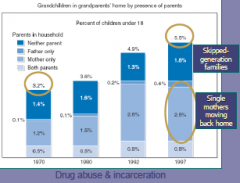
-- men are higher in "married" column b/c they are alive and married (more likely to remarry)
--women end up in the widowed category b/c they outlive their husband (more like to NOT remarry) --divorce rate= relatively low but WILL rise due to cohort |
|
|
Marital Satisfaction in Adulthood
|
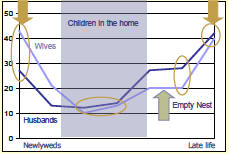
--Women are happier as newlyweds. Men see marriage as a loss of freedom
--women fall below men when they have kids b/c of the pressure to take care of the children |
|
|
Marital Satisfaction in Adulthood: alt. scenarios
|
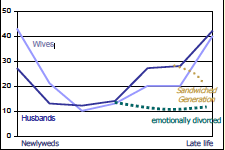
--sandwiched generation: grandparents move back in w/ parents
--emotionally divorced: so used to taking care of kids you don't have eyes for your partner anymore |
|
|
Age Differences in Couples: Aim & Participants
(Levenson, Carstensen, & Gottman, 1994) |
• Aim: Examine positive & negative emotion in middle-aged & older couples’ conversations
•Participants --156 healthy, middle-aged & older couples --All currently working --85% Caucasian --Both satisfied & unsatisfied couples… why? |
|
|
Age Differences in Couples: Methods
(Levenson, Carstensen, & Gottman, 1994) |
•Method: natural conversation scenario
•Day 1 --Neutral conversation about day’s events --Identify a conflict topic & have conversation --Identify a pleasant topic & have conversation •All conversations were videotaped •Day 2: Watch videotape & gave continuous self-report of emotion |
|
|
Age Differences in Couples: Results-Pleasant Topic
(Levenson, Carstensen, & Gottman, 1994) |
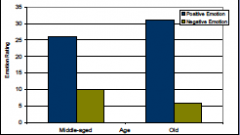
--Older couples derive more pleasure out of
discussing pleasant topics |
|
|
Age Differences in Couples: Results- Conflict
(Levenson, Carstensen, & Gottman, 1994) |
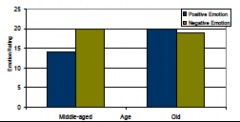
--Older couples also have more positive
emotion when discussing conflicts --they make bad topics more pleasant |
|
|
Personality: conclusion
|
--After years of marriage Older adults are more:
1) satisfied, &… 2) Better able to deal with negative situations |
|
|
6 Phases of Retirement: Stage, Description, and Examples
|
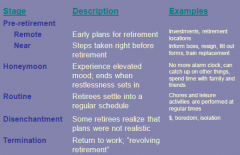
|
|
|
General Facts about Retirement
|
--only 24% of women and 44% of men still work full-time after age 62
--With life expectancy over 75, people who retire at 60 can expect to spend about 15 years in retirement (20% of their life). -- Two major factors determine when people retire: (1) health (2) finances --Bridge jobs |
|
|
The Dying Process: Kübler-Ross’s 5 Stage Theory
|
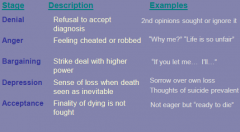
|
|
|
The Dying Process: Kübler-Ross’s 5 Stage Theory FINDINGS
|
•Represents range of emotions during dying, but…
-Not a “sequence” (not in order) -Not universal (not everyone) -Duration in each stage varies •There is an end to the dying process |
|
|
When does death begin?
|
•Brain death: (e.g., no eye
movements, respiration) -No change after 24 hours -All criteria must be met -Rule out “mimics” •Persistent vegetative state (PVS): -no cortical (e.g., thinking), but -brainstem (e.g., breathing) activity -sleep/wake cycle - 1 month minimum -PVS's live close to 7 years |
|
|
Aging successfully: losses vs. gains
|
--Losses in physical & cognitive functioning (but not entirely and not always!)
--Stability and gains in personality & social relationships |
|
|
Coping Changes and problem solving
|
--strategic knowledge: b/c they're older they know how to deal better
--compensating for loss: adults have to change coping strategies depending on the situation --passive emotional regulation: not directly dealign w/ prob --proactive emotion regulation: confront probs/emotions --avoidance: act as if there was no prob |
|
|
strategies for Coping with physical decline
|
1) assimilation: modify behavior to meet or maintain activity
2) accommodation: modify goals or standards to cope 3) immunization: evidence of loss is reinterpreted in a more positive way |
|
|
Control
|
--Locus of control: belief about pos. and neg. things
--Internal control: its you ability --External control: you have no control --Primary control: exerting influence on the external world --secondary control: change w/in individual |
|
|
Social support: types and 3 benefits
|
--Social support: assistance form social network
--social network: fam/friends who are close to us --Instrumental support: help w/ specific tasks --emotional support: help w/ emotion --convoy model: ppl in social network tend to move thru life together (watching and supporting each other) --Benefits: 1) social factors: help in buffering stress 2) psych factors: pos. emotions and sense of control 3) beh. factors: healthy/unhealthy beh influenced by support network |
|
|
Why sexual activity declines
|
-sex horomones decrease
-menopause -health/medications -decreased ability of partner (men only) -social unacceptability |
|
|
6 traits of Friendships and socioemotional selectivity theory
|
-voluntary
-reciprocal -self-disclosure -equality -emotional attatchment -overlapping interest --socioemotional selectivity theory: older ppl develop an increased attention to emotional factors in their relationships due to an awareness that time is limited |
|
|
Religion and its benefits
|
-Religion: community of ppl w/ same beliefs
-spirituality: private, emotional, intellectual connection w/ a higher power --demand/restrictions of faith may lead to better health (no drinking, sex, drugs, etc) --Prayer and Meditation: way to cope w/ stress --social support of religious community --network expansion: meet ppl @ religious gatherings (church) --provides a more positive outlook |
|
|
PVS Wills and Wishes
|
--Living will: specifies types of treatments someone wants/doesnt if they become PVS
--Five wishes: info behind just med. treat. (how comfy they want to be, how they want to be treated, what they wish to tell loved ones) --Health care durable power of attorney: another person is the decision maker for health care decisions of PVS --Do Not Resuscitate (DNR): Do not try to save them --Do Not Hospitalize (DNH): don't take them to the hospital but life saving procedures may be performed |
|
|
Euthanasia
|
--greek for 'good death'
--refusing life-sustaining technology --passive euthanasia: nothing is done to prolong life --active euthanasia (3 types): 1) murder (death at the hands of another) 2) suicide 3) Physician-Assisted Suicide: prescribed drugs by doctor |
|
|
Bereavement, mourning, grief
|
--survival (of another death)
--mourning: socially acceptable way to express grief --grief: coping w/ loss and emotions experienced --anticipatory grief: mourning while person is still alive= less grief when they actually die -4 grief phases: 1) numbing 2) yearning/searching 3) disorganization/despair 4) reorganization --bereaved ppl higher mortality than married ppl |
|
|
Treatments/support for Bereaved
|
--bibliotherapy: reading a lot
--Writing --self-help groups --family and social support |

